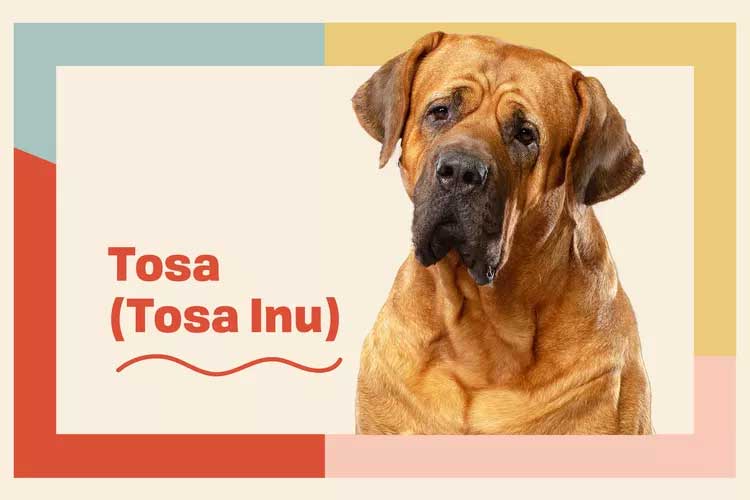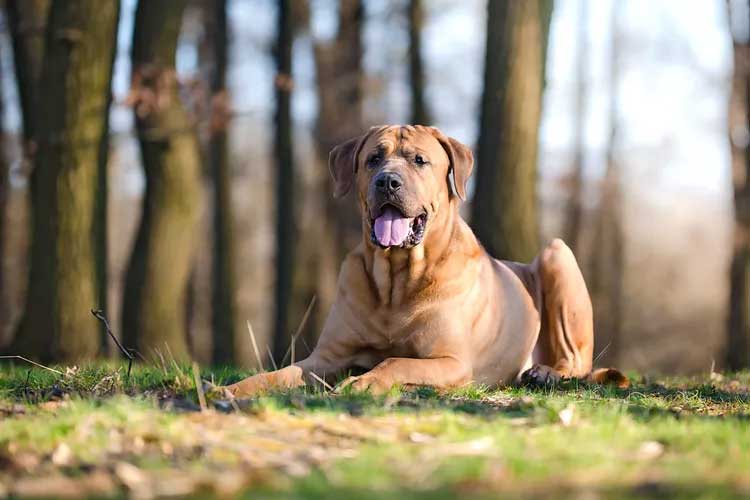The Tosa is known as the sumo wrestler of the canine world. Learn what it takes to care for these dogs that excel in size, patience, and courage.

Tosa Overview
| OFFICIAL NAME | Tosa |
| COMMON NAME | Tosa |
| PET HEIGHT | 21 to 23 inches |
| PET WEIGHT | 100 to 200 pounds |
| LIFESPAN | 10 to 12 years |
| GOOD WITH | families |
| TEMPERAMENT | aloof, gentle |
| INTELLIGENCE | high |
| SHEDDING AMOUNT | infrequent |
| EXERCISE NEEDS | medium |
| ENERGY LEVEL | calm |
| VOCAL LEVEL | when necessary |
| DROOL AMOUNT | medium |
| BREED GROUP | none |
| BREED SIZE | extra large (101 lbs. or more) |
| COAT LENGTH | short |
| COLORS | black, fawn, red |
| PATTERNS | bicolor, brindle |
| OTHER TRAITS | easy to groom, good hiking companion, high prey drive, strong loyalty tendencies |
The Tosa goes by several names. Tosa Inu. Tosa dog. Tosa token. Japanese fighting dog. Japanese mastiff. But regardless of which moniker you settle on, one attribute of this rare and revered breed that remains consistent (and quite hard to miss) is his stately size.
Tosas were originally bred to throw that weight around the dogfighting rings of Japan, but in the U.S. you're much more likely to find them employed as full-time family companions. That's because despite their imposing appearance, Tosas are known for being incredibly calm, patient, and loving with their humans.
Still, with great size comes great responsibility—for the owner, that is! A gentle giant is still a giant, so an experienced owner is best for these pups.
Appearance
The Tosa Inu could be a major contender for the title of 'Most Athletic' in their high school yearbook," says Georgina Ushi Phillips, DVM, advising veterinarian and writer for Not A Bully. However, with their stamina, powerful muscles, and large bodies, she says you'd be more likely to find them on the football field than on a cross country team.
Ushi Phillips notes that while Japanese-bred Tosas are impressively sized (up to 130 pounds), Tosas in the U.S. are even bigger and can weigh up to 200 pounds. For scale, that's about as much as a front-loading washing machine. Or, to use a more canine-friendly method of measurement, it would take 10 average-sized dachshunds to equal the weight of one Tosa. The breed is no slouch in the height department either—literally. Their minimum height from paws to shoulders is just under 2 feet (21.5 to 23.5 inches).
Tosas have broad heads, wrinkled brows, square muzzles, and dark brown eyes. Their thin, high-set ears hang down by their cheeks, and their muscular necks have a characteristic dewlap (fold of loose skin). Tosas wear easy-to-groom, low-shedding coats that are short and smooth and come in shades of black, brindle, fawn, and red, and you may also find white markings on their paws or chest. This short, dense fur continues onto their long, tapered tails.
Temperament
There's plenty more to marvel about the Tosa beyond his stature. Looking at him, you might expect a stoic dog. But Ushi Phillips says they can be outgoing and even playful or silly with their families. However, she explains that you can generally expect them to be reserved around people they don't know.Ushi Phillips says Tosas are intelligent and eager to please—two traits that serve them well during training. And while these athletic all-stars enjoy being active, they don't mind being called back to the "bench" to relax with their owners.
Living Needs
Tosa Inus are not for the inexperienced dog owner," Ushi Phillips explains. "And because these dogs are massive, have been [traditionally] bred for fighting, and have a powerful prey drive, they do best in a home without any other pets."She describes Tosas as loyal family dogs who can do well with kids but warns that very young children who are still learning how to interact with dogs may not make the best companions. As with all breeds, puppy playtime with kiddos should be supervised.

Ushi Phillips says the ideal environment for a Tosa would include a large fenced yard where he can exercise freely. "As with most dogs this size, you shouldn't expect them to go on a long jog with you," she adds. "But they still do best with 45 minutes to an hour of exercise a day."
Apartments, on the other hand, are not recommended—in part because it would be difficult for a Tosa to get the exercise he needs in such a confined space. But perhaps more importantly, apartments put Tosas in a position where there's always new people and dogs, which can make him wary and uncomfortable.
Because of their history, the Tosa dog breed is banned in several countries, including the United Kingdom, Australia, Denmark, and Norway. Thankfully, the U.S. isn't one of them. According to Ushi Phillips, these bans can be difficult to enforce and can cause more harm than good.
"Breed-specific legislation is always problematic since it fails to address the true root of the problem, which is irresponsible and even simply dangerous pet ownership," Ushi Phillips explains. "It's true that the Tosa is a massive dog that should only be in the care of experienced and responsible owners. Unfortunately, breeds like the Tosa often attract the opposite kind of owner, and many countries see banning as the safest option."
Care
At the risk of sounding like a broken record, arguably the most important component of a Tosa's care is an experienced, committed, and responsible owner. Specifically, Ushi Phillips says a Tosa owner should understand the importance of socializing their dog as early as possible. "Tosas are naturally aloof around people they don't know," she explains. "Without proper socialization, that aloofness could turn into suspicion."But socialization is just the first step. Owners will need to be skilled in positive reinforcement training as well, Ushi Phillips says. With their intelligence and desire to please, Tosas respond well to reward-based training (aka, lots of treats and "good boy" affirmations).
If this sounds overwhelming, keep in mind that you don't have to do it alone. Even if you're an experienced and dedicated owner, it can take a village to raise a properly socialized and trained dog. Reach out to your veterinary team; they can recommend a reputable trainer in your area who can partner with you in your pet's care.

To keep your athletic Tosa's brain and body in tip-top shape, try taking him on hikes and walks through the neighborhood. Long, intense exercise sessions aren't recommended for any dog this size (especially on hot days), but a simple game of fetch in the backyard or time spent learning a new trick can provide him with the mental and physical outlets he needs.
Caring for your Tosa's short, smooth coat couldn't be simpler. The breed only needs occasional brushing and bathing to keep their skin and fur healthy. Otherwise, your Tosa will just need regular nail trims and teeth brushing to stay healthy.
Health
Tosas tend to be healthy dogs who can live as many as 12 human years. But as with any breed, they can be predisposed to certain conditions:Hip and elbow dysplasia are developmental conditions in which the joints are deformed and loose. This can lead to pain, mobility problems, and osteoarthritis. Though the signs of these conditions often don't appear until adulthood, you can screen your Tosa at a young age using X-rays. These radiographs will help your veterinarian determine how likely it is that your dog will have problems in the future and whether you should consider early surgical intervention.
Gastric dilatation volvulus (GDV), also called bloat, occurs when food, gas, or liquid gets trapped in the stomach and causes it to expand. In some cases, the stomach can grow as large as a basketball. Not surprisingly, this expansion can cause harm outside of the digestive system, too. Pressure on the lungs can make breathing difficult, and if the stomach twists on itself like a towel being wrung out, it can cut off blood flow to vital organs—a serious problem that requires emergency surgery.
History
While dogfighting has been part of Japanese culture since the 14th century, the arrival of American Commodore Matthew Perry to Tokyo Bay in 1853 and subsequent re-establishment of trade and discourse between Japan and the Western world (for the first time in 200 years) is an important part of the Tosa's story. That's because the breed is a mixture of the Japanese Shikoku and dogs brought to Japan by Western traders.
According to the Federation Cynologique Internationale (FCI), an international canine organization, bulldogs, mastiffs, German pointers, and Great Danes were used to improve the breed through sequential mating. Some accounts also list Saint Bernards and bull terriers as contributors to the breed, though the years they were used aren't known.
Fun Facts
Tosas get their name from the historic region where they were bred on the Japanese island of Shikoku.The Tosa is sometimes compared to another famous Japanese warrior you may be more familiar with: the sumo wrestler. So don't be surprised if you hear them referred to as the sumo wrestlers of the canine world.
Of all the Japanese dog breeds, the Tosa is the largest.